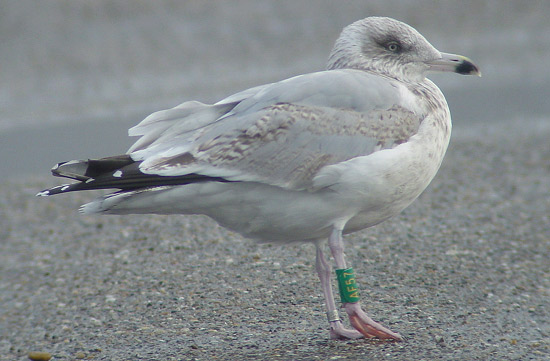 Herring
Gull - Zilvermeeuw (argentatus & argenteus): sub-adult November
Herring
Gull - Zilvermeeuw (argentatus & argenteus): sub-adult November
(last update: 31 januari 2005)
Home
Links
to Gull Sites
Gull Taxa
Gull Topography
Grey & Colour Charts
Locations in NW Europe
Summaries of Articles
About ORG
@
Herring Gull sub-adult AF57, November 17 2002, Brouwersdam, the Netherlands (51.45N,03.51E).
A sub-adult ringed on the island Helgoland, Germany. A pale grey individual matching western argenteus in the grey tone of the upper-parts. But note the complete merged tip and mirror on P10 on this sub-adult bird, a feature more commonly found in argentatus. Note also the many barred wing-coverts, creating a clearer immature wing than in most argenteus. The birds on Helgoland may appear intermediate between argenteus and argentatus.
From June to October, sub-adult Herring
Gull have a complete moult to so-called "winter plumage".
As long as the old outer third generation primaries are visible (until
August), ageing as 4cy is rather straightforward. From November onwards,
4cy birds much resemble adult birds, except that the bare parts still show
immature features: the black bill-band is obvious, extending over both
upper and lower mandible. On average, this plumage develops a more
pronounced winter 'hood' than in full adults: dense streaking on head,
especially around the eye and in the hind-neck. The upper-parts,
wing-coverts and tertials appear adult-like grey from 4cy October onwards.
The fourth generation tail-feathers are plain white.
The new fourth generation primaries are similar to the adult primaries,
although the primary tips may appear slightly smaller, but otherwise
similar in pattern: grey inner-wing and black outer-wing. Both P9 and P10
show a mirror. P5 shows small black sub-terminal markings in argenteus,
concentrated on the outer-web as a clear-cut black angular spot and rarely
extending on the inner-web as a diffuse streak. There may be some black on
P4 as well. Adult argenteus show a different pattern in the outer
primaries, compared to northern argentatus. In argentatus,
especially from northern Scandinavia, the black marking on P5 is very
limited and diffuse or this is sub-terminal markings are completely
lacking on P5.
Argenteus has more black in the outer primaries, including a black
band on the top of p10 in most birds, dividing the tip from the mirror. If
the black sub-terminal band on P10 is broken, the outer-web of p10 still
shows black marking. Argentatus normally lacks sub-terminal
markings on the outer-web of P10.
The scapular coverts are plain grey, lacking white crescents. The tertials
show obvious white tips. The iris is yellow. The bill is yellow with a red
gonydeal spot confined to the lower mandible. The orbital ring is
yellow-orange or orange-red. The legs are flesh-pink.
